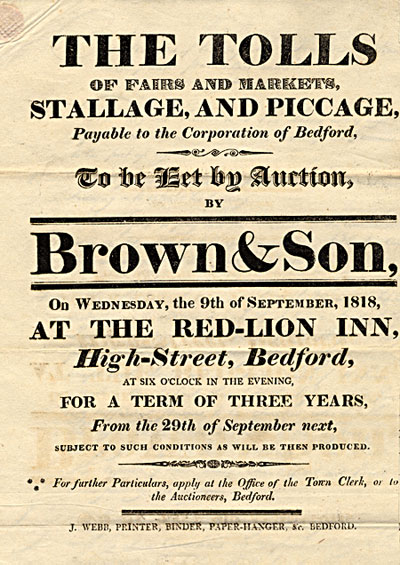Off to market
The granting of the right to hold a market or fair was an important sign of status and the documents which record the grant are often suitably impressive.

Ref. LJeayes682 (above) dates from 1319. By it King Edward II grants to Ralph the right to hold a market on his manor at Silsoe every Wednesday. When in the early 18th century later owners of the manor wished to confirm this right they had the document transcribed and translated (note the transcribers explanations of some of the phrases used and the 20th century damage caused by a paperclip!):

The upshot of this was new letters patent from King George, which are kept in an elaborate leather bound and gold tooled box (below):


BorBA1/22 is the letter patent, dated 27 April 1554, from Mary I to the mayor, bailiff, burgesses and commonalty of Bedford granting 2 fairs (one to be held either on the 8-9 September or the 13-14 December and one to be held on the Tuesday and Wednesday of the first week in Lent), and a market to be held on Tuesday every week in the parish of St Mary:

In 1556 a dispute arose which resulted in the fairs being moved to the parish of St Paul, the inhabitants of the parish of St Mary being paid £6 13s 6d towards the cost of the new letters patent.
In 1911 the Borough of Luton obtained an Act of Parliament, which, amongst other things, confirmed the acquisition by the Borough of the right to hold fairs and markets formerly belonging to the Lord of the Manor of Luton. (BorL/CB1/7):

The reason that the right to hold markets and fairs was so important was, of course, that it was a way to make money as it brought with it the right to extract tolls for every stall and animal brought to market. In 1818 the Borough of Bedford sold a three year lease on the tolls at auction (BorBB11/2/16):

Charges were periodically reviewed. When, in 1865, the cattle market was moved to Commercial Road in Bedford a new table of fees was drafted for all types of animal (BorBB11/31/7):

And in 1869 new fees for market stalls were authorised by the home office (BorBB11/31/15):

Our Quarter Sessions document this time shows that not everyone was happy to pay the tolls. The 27th April 1842 was the day of Bedford fair and Mr Low was bringing three cows to market. For some reason he refused to pay the toll on his cows, so the toll collector took one of the cows in lieu of the toll and left it in the charge of one of the town's constables. This didn't go down well with Low who, aided by a crowd of people, drove the cow through the hedge. A scuffle between the constable and Low ensued. The constable asked Thomas Crowsley, a beerseller from Wilshamstead, for help but Thomas decided to side with Low and was eventually charged with assault on the constable (QSR1842/3/5/57).
In this case the accused was acquitted. However, it is probably no surprise to discover that markets and fairs are often the scene of crime. The crowds attracted by the event were themselves attractive to pickpockets. In 1671 at Dunstable fair a group of three men were accused of theft from the person. One of the men, Richard Ashton late of Warwick, gave a curious account of why he was there (HSA1671/W/ 102). He claimed that about eight weeks previously he and his wife and children had arrived at Hockliffe in Bedfordshire where his wife had been 'brought to bed and lay there about a month at which time she went from there with foure children'. Richard hadn't seen her or the children since 'having been up & downe about the country' and, having been at Hitchin Market the day before to look for his wife without success, claims to have come to Dunstable fair thinking to meet his wife there. Unfortunately we don't know whether the couple were ever reunited:

For more escapades associated with markets, have a look at 17th Century crime at Leighton Buzzard .